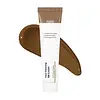What's inside
What's inside
 Key Ingredients
Key Ingredients

 Benefits
Benefits

 Concerns
Concerns

 Ingredients Side-by-side
Ingredients Side-by-side

Water
Skin ConditioningCI 77492
Cosmetic ColorantEthylhexyl Methoxycinnamate
UV AbsorberButylene Glycol
HumectantCyclopentasiloxane
EmollientEthylhexyl Salicylate
UV AbsorberLauryl Polyglyceryl-3 Polydimethylsiloxyethyl Dimethicone
Skin ConditioningHydrogenated Poly(C6-14 Olefin)
EmollientNiacinamide
SmoothingZinc Oxide
Cosmetic ColorantCyclohexasiloxane
EmollientCI 77891
Cosmetic ColorantCI 77491
Cosmetic ColorantCI 77499
Cosmetic ColorantSodium Chloride
MaskingDisteardimonium Hectorite
StabilisingSorbitan Sesquioleate
EmulsifyingMica
Cosmetic ColorantTriethoxycaprylylsilane
Zinc Stearate
Cosmetic ColorantDextrin Palmitate
EmulsifyingCaprylyl Glycol
EmollientPanthenol
Skin ConditioningAllantoin
Skin ConditioningCentella Asiatica Extract
CleansingDimethicone/Vinyl Dimethicone Crosspolymer
Skin ConditioningAluminum Hydroxide
EmollientCaprylhydroxamic Acid
Glycerin
HumectantAdenosine
Skin Conditioning1,2-Hexanediol
Skin ConditioningTocopherol
AntioxidantMadecassoside
AntioxidantAsiaticoside
AntioxidantAsiatic Acid
Skin ConditioningMadecassic Acid
Skin ConditioningWater, CI 77492, Ethylhexyl Methoxycinnamate, Butylene Glycol, Cyclopentasiloxane, Ethylhexyl Salicylate, Lauryl Polyglyceryl-3 Polydimethylsiloxyethyl Dimethicone, Hydrogenated Poly(C6-14 Olefin), Niacinamide, Zinc Oxide, Cyclohexasiloxane, CI 77891, CI 77491, CI 77499, Sodium Chloride, Disteardimonium Hectorite, Sorbitan Sesquioleate, Mica, Triethoxycaprylylsilane, Zinc Stearate, Dextrin Palmitate, Caprylyl Glycol, Panthenol, Allantoin, Centella Asiatica Extract, Dimethicone/Vinyl Dimethicone Crosspolymer, Aluminum Hydroxide, Caprylhydroxamic Acid, Glycerin, Adenosine, 1,2-Hexanediol, Tocopherol, Madecassoside, Asiaticoside, Asiatic Acid, Madecassic Acid
Water
Skin ConditioningCoco-Caprylate
EmollientBis-Ethylhexyloxyphenol Methoxyphenyl Triazine
Skin ConditioningOctyldodecanol
EmollientEuphorbia Cerifera Cera
AstringentGlyceryl Stearate
EmollientPolyglyceryl-6 Stearate
EmollientLactic Acid
BufferingCetyl Alcohol
EmollientBoron Nitride
AbsorbentGlycerin
HumectantSodium Anisate
AntimicrobialSodium Levulinate
Skin ConditioningTrihydroxystearin
Skin ConditioningSynthetic Fluorphlogopite
Glyceryl Caprylate
EmollientPolyglyceryl-6 Behenate
Emulsion StabilisingGellan Gum
Sodium Phytate
Jojoba Esters
EmollientXanthan Gum
EmulsifyingTin Oxide
AbrasiveCI 77491
Cosmetic ColorantCI 77492
Cosmetic ColorantCI 77499
Cosmetic ColorantCI 77891
Cosmetic ColorantWater, Coco-Caprylate, Bis-Ethylhexyloxyphenol Methoxyphenyl Triazine, Octyldodecanol, Euphorbia Cerifera Cera, Glyceryl Stearate, Polyglyceryl-6 Stearate, Lactic Acid, Cetyl Alcohol, Boron Nitride, Glycerin, Sodium Anisate, Sodium Levulinate, Trihydroxystearin, Synthetic Fluorphlogopite, Glyceryl Caprylate, Polyglyceryl-6 Behenate, Gellan Gum, Sodium Phytate, Jojoba Esters, Xanthan Gum, Tin Oxide, CI 77491, CI 77492, CI 77499, CI 77891
 Reviews
Reviews

Alternatives
Ingredients Explained
These ingredients are found in both products.
Ingredients higher up in an ingredient list are typically present in a larger amount.
Ci 77491 is also hydrated iron III oxide. It's sole purpose is to give a red/pink hue to products.
Iron III oxides are classified as inorganic chemicals for coloring.
Synthetically created Ci 77491 is considered safer than those naturally found. This is because the synthetically created version may contain less impurities. Iron oxides are generally non-toxic and non-allergenic.
Learn more about CI 77491Ci 77492 is also hydrated iron III oxide. It's sole purpose is to give a yellow hue to products.
Iron III oxides are classified as inorganic chemicals for coloring.
Synthetically created Ci 77492 is considered safer than those naturally found. This is because the synthetically created version may contain less impurities. Iron oxides are generally non-toxic and non-allergenic.
Learn more about CI 77492Ci 77499 is also hydrated iron III oxide. It is created from mixing red and black iron oxides. This helps give shades of darkness to a product.
Iron III oxides are classified as inorganic chemicals for coloring.
Ci 77891 is a white pigment from Titanium dioxide. It is naturally found in minerals such as rutile and ilmenite.
It's main function is to add a white color to cosmetics. It can also be mixed with other colors to create different shades.
Ci 77891 is commonly found in sunscreens due to its ability to block UV rays.
Learn more about CI 77891Glycerin is already naturally found in your skin. It helps moisturize and protect your skin.
A study from 2016 found glycerin to be more effective as a humectant than AHAs and hyaluronic acid.
As a humectant, it helps the skin stay hydrated by pulling moisture to your skin. The low molecular weight of glycerin allows it to pull moisture into the deeper layers of your skin.
Hydrated skin improves your skin barrier; Your skin barrier helps protect against irritants and bacteria.
Glycerin has also been found to have antimicrobial and antiviral properties. Due to these properties, glycerin is often used in wound and burn treatments.
In cosmetics, glycerin is usually derived from plants such as soybean or palm. However, it can also be sourced from animals, such as tallow or animal fat.
This ingredient is organic, colorless, odorless, and non-toxic.
Glycerin is the name for this ingredient in American English. British English uses Glycerol/Glycerine.
Learn more about GlycerinWater. It's the most common cosmetic ingredient of all. You'll usually see it at the top of ingredient lists, meaning that it makes up the largest part of the product.
So why is it so popular? Water most often acts as a solvent - this means that it helps dissolve other ingredients into the formulation.
You'll also recognize water as that liquid we all need to stay alive. If you see this, drink a glass of water. Stay hydrated!
Learn more about Water